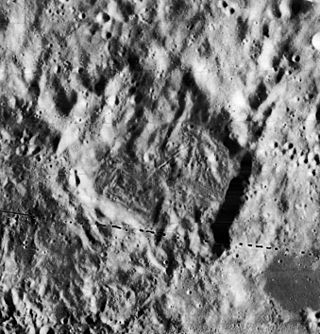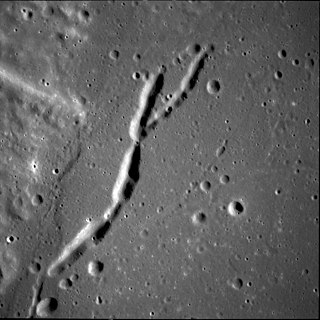
Rimae Fresnel is a 90km-long arcuate escarpment on the Moon at 28°00′N4°00′E / 28.0°N 4.0°E . [1] Both the escarpment and the nearby Promontorium Fresnel were named after the French physicist Augustin-Jean Fresnel. [2] [3] [4]

Rimae Fresnel is a 90km-long arcuate escarpment on the Moon at 28°00′N4°00′E / 28.0°N 4.0°E . [1] Both the escarpment and the nearby Promontorium Fresnel were named after the French physicist Augustin-Jean Fresnel. [2] [3] [4]

Mare Humorum is a lunar mare. The impact basin it is located in is 425 kilometers (264 mi) across.

Montes Haemus is a mountain range that forms the southwestern edge of the Mare Serenitatis basin on the Moon. They form a less prominent mirror image of the Montes Apenninus range to the west, and curve up to nearly join at the northern end. The eastern edge terminates with the Promontorium Archerusia, to the northwest of the crater Plinius. This end reaches a gap where the Mare Serenitatis to the north joins the Mare Tranquillitatis to the south.

Plinius is a prominent lunar impact crater on the border between Mare Serenitatis to the north and Mare Tranquilitatis to the south. Its diameter is 41 km. The crater is named after the Roman natural scientist and author Pliny the Elder. To the south-southeast of Plinius is the crater Ross, and to the northeast is Dawes. Just to the north is a system of rilles named the Rimae Plinius and touching it is the Brackett crater which is more than a crater diameter north. At the northwest edge of the rille is the Promontorium Archerusia, a cape off the western rim that encloses the Mare Serenitatis.

Cauchy is a small lunar impact crater on the eastern Mare Tranquillitatis. It was named after French mathematician Augustin-Louis Cauchy. It is circular and symmetric, with a small interior floor at the midpoint of the sloping inner walls. Due to the high albedo of this bowl-shaped formation, it is particularly prominent at full Moon.

Bode is a small crater located near the central region of the Moon, to the northwest of the joined craters Pallas and Murchison. It lies on a region of raised surface between the Mare Vaporum to the northeast, Sinus Aestuum to the west, and Sinus Medii to the southeast. The crater was named after German astronomer Johann Elert Bode.

Atlas is a prominent lunar impact crater that is located in the northeast part of the Moon, to the southeast of Mare Frigoris. Just to the west is the slightly smaller but still prominent crater Hercules. Northeast of Atlas is the large crater Endymion.

Maupertuis is the remnant of a lunar impact crater that is located in the northern part of the Moon's near side. It lies in the stretch of rugged terrain north of Sinus Iridum, a bay in the northwestern corner of Mare Imbrium. To the north lies the crater La Condamine, and Mare Frigoris.

Santos-Dumont is a small lunar impact crater that lies in the northern end of the Montes Apenninus range at the eastern edge of the Mare Imbrium. It is located about 30 kilometers to the northeast of Mons Hadley, a mountain massif.

Dunthorne is a small lunar impact crater that is located to the northwest of the small lunar mare called Palus Epidemiarum, in the southwest part of the Moon's near side. It was named after British astronomer Richard Dunthorne. It lies to the southwest of the crater Campanus, east of Vitello. Due south is Ramsden.

Sinus Honoris is located along the western edge of the Mare Tranquillitatis located on the surface of the near side of the Moon. The selenographic coordinates of this feature are 11.7° N, 17.9° E. It has a diameter of 112 km.

Palus Putredinis is a small lunar mare in the basin of Mare Imbrium. It stretches from the crater Archimedes southeast toward the rugged Montes Apenninus range located on the southeastern edge of Mare Imbrium. This region is a nearly level, lava-flooded plain bounded by the crater Autolycus and nearby highlands to the northeast and the foothills of the Montes Archimedes to the southwest. The selenographic coordinates are 27.4° N, 0.0° E, and it lies within a diameter of 180 kilometers (110 mi).

Rupes Kelvin is an escarpment near Promontorium Kelvin on the near side of the Moon, at 27.3°S 33.1°W. It is 86 km long. It takes its name from Promontorium Kelvin, which was named after the Irish scientist, physicist and engineer William Thomson, 1st Baron Kelvin.

Promontorium Laplace is a raised mountainous cape situated at the end of Montes Jura in Mare Imbrium on the near side of the Moon. Its selenographic coordinates are 46.8° N, 25.5° W and it is 2600 meters high. It forms the northeast boundary of the bay of Sinus Iridum.

Promontorium Heraclides is a raised mountainous cape situated in Mare Imbrium on the near side of the Moon. Its selenographic coordinates are 40.3° N, 33.2° W and it is 50 km in diameter. It marks the western edge of the bay of Sinus Iridum. Promontorium Heraclides is named after Heraclides Ponticus, a Greek philosopher and astronomer. The Soviet lunar probe Luna 17 landed about 30 km from Promontorium Heraclides on November 17, 1970. The land form is depicted as the face of a woman looking across Sinus Iridum in a 1679 lunar map by Giovanni Domenico Cassini; this depiction, of disputed origin, is known as the "Moon Maiden".

Promontorium Agarum is a raised mountainous cape protruding into the southeast of Mare Crisium on the near side of the Moon. It protrudes into the mare up to 40 km and its width is about 80 km. Its coordinates are 13.87°N 65.73°E.

Promontorium Taenarium is a headland on the near side of the Moon. It is located in the eastern end of Mare Nubium. Its length is about 70 km. Its coordinates are 18°39′0″S7°28′24″W.

Promontorium Archerusia is a headland on the near side of the Moon. It separates the lunar mares of Mare Serenitatis and Mare Tranquilitatis. Its coordinates are 16.8°N 21.9°E.

Promontorium Fresnel is a headland on the near side of the Moon. It is located at the northern end of the Montes Apenninus and separates the lunar mares of Mare Serenitatis and Mare Imbrium. Just west of the mountainous cape is Rimae Fresnel. Both features were named after the French physicist Augustin-Jean Fresnel. Its coordinates are 28.63°N 4.75°E.

Promontorium Kelvin is a headland on the near side of the Moon. It is located in the southeast of the Mare Humorum. It is close to Rupes Kelvin. Its length is about 45 km. Its coordinates are 26.95°S 33.45°W. It was named after the British scientist, physicist and engineer William Thomson, 1st Baron Kelvin.

Rimae Secchi is a system of rilles on the Moon, in northwestern Mare Fecunditatis. They are approximately 40 km long and run along the shore of the mare.